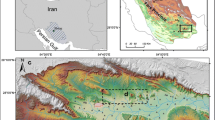Abstract
A grid-based erosion model is developed by integrating the distributed hydrological model, BTOPMC, with the modified USLE to estimate soil erosion and sediment outflow during single storms. The possible sheet, rill, channel erosion types, and sediment transport processes are considered within each grid under the model structure. Instead of representing the sheet erosion and rill erosion separately, the classic USLE method is modified to simulate the lumped sheet–rill erosion during storms. In the modification, the runoff ratio and a relevant correction coefficient are brought into the R-factor which improves the model’s applicability in predicting erosion during single storms. Instead of representing a grid with a unique erosion type, a channel component is assumed to exist in each grid, and its width varies with the upstream contributing area of the grid. This assumption avoids the problems that are caused by the difference between the channel widths in the upstream area and the downstream area if the grid is simply recognized as a channel grid. It also enables the model to be applicable in simulating soil erosion and sediment outflow from a large catchment. Through a case study in the Lushi catchment, China, the results show an overall satisfactory accuracy for the selected events. Moreover, by analyzing the spatial distribution of soil erosion or deposition, the erosion-prone areas are identified for the prioritization purpose.











Similar content being viewed by others

References
Beasley DB, Huggins LF, Monke EJ (1980) ANSWERS: a model for watershed planning. Trans ASAE 23:938–944
Beven KJ, Lamb R, Quinn P, Romanovicz R, Freer J (1995) TOPMODEL. In: Signh VP (ed) Computer models of watershed hydrology. Water Resources Publications, Highlands Ranch, pp 627–668
Bingner RL, Murphee CE, Mutchler CK (1989) Comparison of sediment yield models on various watershed in Mississippi. Trans ASAE 32:529–534
Dagan G, Bresler E (1983) Unsaturated flow in spatially variable fields, 1. Derivation of model of infiltration and redistribution. Water Res R 19:413–420. doi:10.1029/WR019i002p00413
Daniel GY, Glenn AW, Donalad KM, Keith CM, Ronald LB (2003) User’s guide: revised universal soil loss equation version 2—RUSLE2. USDA, Washington
Foster GR (1982) Modeling the erosion process. In: McCulloch JSG (ed) Hydrologic modeling of small watersheds. ASAE, Washington, pp 297–380
Foster GR, Meyer LD (1977) A runoff erosivity factor and variable slope length exponents for soil loss estimates. Trans ASAE 20:683–687
Kinnell PIA (2003) Event erosivity factor and errors in erosion predictions by some empirical models. Aust J Soil 41:991–1003. doi:10.1071/SR02123
Nearing MA, Foster GR, Laflen JM (1989) A process based soil erosion model for USDA water erosion prediction project. Trans ASAE 32:1587–1593
Ozcan AU, Erpul G, Basaran M, Erdogan HE (2008) Use of USLE/GIS technology integrated with geostatistics to assess soil erosion risk in different land uses of Indagi Mountain Pass—Canklrl, Turkey. Environ Geol 53:1731–1741. doi:10.1007/s00254-007-0779-6
Philip JR (1957) The theory of infiltration: 1. The infiltration equation and its solution. Soil Sci 83:435–448
Renard KG, Foster GR et al (1997) Predicting soil erosion by water: a guide to conservation planning with the revised universal soil loss equation (RUSLE). Agricultural handbook, No. 703. USDA, Washington
Sherman LK (1943) Comparison of F-curves derived by the methods sharp and Holtan and of Sherman and Mayer. Trans AGU 24:465–467
Shi XZ, Yu DS, Warner ED (2004) Soil database of 1:1, 000, 000 digital soil survey and reference system of the Chinese Genetic Soil Classification System. Soil Surv Horiz 45:111–148
Shrestha S, Kazama F (2007) Assessment of surface water quality using multivariate statistical techniques: A case study of the Fuji river basin, Japan. Environ Model Softw 22:464–475. doi:10.1016/j.envsoft.2006.02.001
Shrestha S, Babel MS, Gupta AD, Kazama F (2006) Evaluation of annualized agricultural nonpoint source model for a watershed in the Siwalik Hills of Nepal. Environ Model Softw 21:961–975. doi:10.1016/j.envsoft.2005.04.007
Sivapalan M, Wood EF (1986) Spatial heterogeneity and scale in the infiltration response of catchments. In: Gupta VK (ed) Scale problems in hydrology. Springer, New York, pp 81–106
Takeuchi K, Ao TQ, Ishidaira H (1999) Introduction of block-wise use of TOPMODEL and Muskingum–Cunge method for the hydro-environmental simulation of a large ungauged basin. Hydro Sci J 44:633–646
Takeuchi K, Hapuarachchi P, Zhou MC, Ishidaira H, Magome J (2007) A BTOP model to extend TOPMODEL for distributed hydrological simulation of large basins. Hydrol Process 22:3236–3251. doi:10.1002/hyp.6910
Tiwari AK, Risse LM, Nearing MA (2000) Evaluation of WEPP and its comparison with USLE and RUSLE. Trans ASAE 43:1129–1135
USDA (1978) Universal soil loss equation data. http://topsoil.nserl.purdue.edu/usle/
Wang GQ, Zhou MC, Takeuchi K, Ishidaira H (2007) Improved version of BTOPMC model and its application in event-based hydrologic simulations. J Geogr Sci 17:73–84. doi:10.1007/s11442-007-0073-2
Wischmeier WH, Smith DD (1965) Predicting rainfall erosion losses from cropland east of the Rocky Mountains. Agricultural handbook, No. 282. USDA, Washington
Yu DS, Shi XZ, Weindorf DC (2006) Relationships between permeability and erodibility of cultivated Acrisols and Cambisols in subtropical China. Pedosphere 16:304–311. doi:10.1016/S1002-0160(06)60056-8
Zheng FL (1998) Erosion and sediment yield in different zones of Loess Plateau. ACT Geographic Sinica 53:422–427 (in Chinese)
Author information
Authors and Affiliations
Corresponding author
Rights and permissions
About this article
Cite this article
Wang, G., Yu, J., Shrestha, S. et al. Application of a distributed erosion model for the assessment of spatial erosion patterns in the Lushi catchment, China. Environ Earth Sci 61, 787–797 (2010). https://doi.org/10.1007/s12665-009-0391-z
Received:
Accepted:
Published:
Issue Date:
DOI: https://doi.org/10.1007/s12665-009-0391-z



